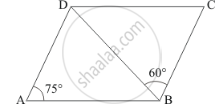Topics
Number Systems
Number Systems
Polynomials
Algebra
Coordinate Geometry
Linear Equations in Two Variables
Geometry
Coordinate Geometry
Introduction to Euclid’S Geometry
Mensuration
Statistics and Probability
Lines and Angles
- Introduction to Lines and Angles
- Basic Terms and Definitions
- Intersecting Lines and Non-intersecting Lines
- Introduction to Parallel Lines
- Pairs of Angles
- Parallel Lines and a Transversal
- Angle Sum Property of a Triangle
Triangles
- Concept of Triangles
- Congruence of Triangles
- Criteria for Congruence of Triangles
- Properties of a Triangle
- Some More Criteria for Congruence of Triangles
- Inequalities in a Triangle
Quadrilaterals
- Concept of Quadrilaterals
- Properties of a Quadrilateral
- Types of Quadrilaterals
- Another Condition for a Quadrilateral to Be a Parallelogram
- Theorem of Midpoints of Two Sides of a Triangle
- Property: The Opposite Sides of a Parallelogram Are of Equal Length.
- Theorem: A Diagonal of a Parallelogram Divides It into Two Congruent Triangles.
- Theorem : If Each Pair of Opposite Sides of a Quadrilateral is Equal, Then It is a Parallelogram.
- Property: The Opposite Angles of a Parallelogram Are of Equal Measure.
- Theorem: If in a Quadrilateral, Each Pair of Opposite Angles is Equal, Then It is a Parallelogram.
- Property: The diagonals of a parallelogram bisect each other. (at the point of their intersection)
- Theorem : If the Diagonals of a Quadrilateral Bisect Each Other, Then It is a Parallelogram
Circles
Areas - Heron’S Formula
Surface Areas and Volumes
Statistics
Algebraic Expressions
Algebraic Identities
Area
Constructions
- Introduction of Constructions
- Basic Constructions
- Some Constructions of Triangles
Probability
- Introduction
- Adjacent Sides of a Quadrilateral
- Opposite Sides of a Quadrilateral
- Adjacent Angles of a Quadrilateral
- Opposite Angles of a Quadrilateral
- Diagonals of a Quadrilateral
- Angle Sum Property of a Quadrilateral
Notes
Sum of Four Angles of a Quadrilateral:
- Cut out a paper in the shape of a quadrilateral.
- Make folds in it that join the vertices of opposite angles.

- Take two triangular pieces of paper such that one side of one triangle is equal to one side of the other.
- Let us suppose that in ∆ABC and ∆PQR, sides AC and PQ are the equal sides.

- Join the triangles so that their equal sides lie side by side.
- We used two triangles to obtain a quadrilateral. The sum of the three angles of a triangle is 180°.
- Hence, The sum of the measures of the four angles of a quadrilateral is 360°.
Theorem
Angle Sum Property of a Quadrilateral:
Theorem: The sum of the angles of a quadrilateral is 360°.

Construction: This can be verified by drawing a diagonal AC and dividing the quadrilateral into two triangles.
Proof:
Let ABCD be a quadrilateral and AC be diagonal.
In △ ABC,
You know that,
∠ B + ∠ BAC + ∠ BCA = 180°........(1)
Similarly, in △ADC,
∠ D + ∠ DAC + ∠ DCA = 180°........(2)
Adding (1) and (2), we get,
∠ B + ∠ BAC + ∠ BCA + ∠ D + ∠ DAC + ∠ DCA = 180° + 180°
Also, ∠ BAC + ∠ DAC = ∠ A and ∠ BCA + ∠ DCA = ∠ C
So, ∠ A + ∠ B + ∠ C + ∠ D = 180° + 180°= 360°
i.e., The sum of the angles of a quadrilateral is 360°.
If you would like to contribute notes or other learning material, please submit them using the button below.
Shaalaa.com | Prove Sum of Interior Angles of a Quadrilateral are 360 Degrees
to track your progress
Series: Sum of Four Angles of a Quadrilateral
0%


